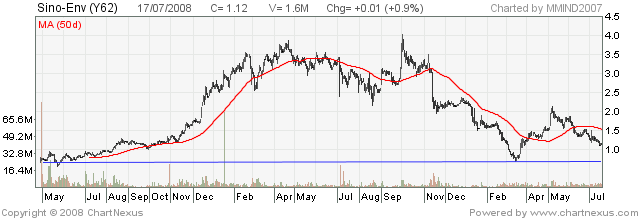I did some study on STI too, not sure what I'm looking for, just fooling around with data
---------------------------------------
While trying to find out more about the compounded returns of investing in STI ETF today, I managed to crunch some numbers for the adjusted close of STI since inception on 28th Dec, 1987 till now. The data that I used comes from Yahoo! finance. Below is the chart (linear y-axis) of STI from inception till last close, on 2nd May 2008.
 http://bp3.blogger.com/_3qF-4FCPF1I/SB6 ... stigif.gif
http://bp3.blogger.com/_3qF-4FCPF1I/SB6 ... stigif.gifWe can see from the STI chart that there are notable periods of time that it dropped sharply. In 1990, 1998, 2003 and 2007, we can see a visual drop in STI. But I think a more appropriate chart to use is a logarithmic y-axis, so that we can better appreciate the change in % of STI.
 http://bp2.blogger.com/_3qF-4FCPF1I/SB6 ... ti+log.gif
http://bp2.blogger.com/_3qF-4FCPF1I/SB6 ... ti+log.gifIt's interesting to take note that while the 1990s and 1998 crashes are very severe, the 2007 subprime crisis which is acting out now is a mere blip on the chart. In fact, the subprime crisis is nothing compared to 1998 where the market crashed below inception level. That must be the dot com crisis that plagued US and possibly spilled over to Singapore shores. (I made a mistake, it's not the dot-com, it's the asian financial crisis of 1997-1998)
It's actually very encouraging to see such charts because it gives hopes to investors that while all seems lost, time itself will right the wrong and correct the excesses, hence there is no need to worry about the current crisis if one's holding power is there. But some may argue that STI ultimately is a collection of a number of big caps ranked in market capitalization, so while STI may rise, retail investors investing in smaller pennies might suffer much more than suggested otherwise. There is also the added complication of survivorship bias where those who didn't survive are taken out of STI, hence STI isn't such a good beacon of hope. Well, that's true.
I further compiled a table that shows the compounded annual growth rate for STI taken at different periods of time : 1 yr, 3 yr, 5, 7, 10 to 20 yrs, just to see what sort of returns one might get from holding STI.
 http://bp2.blogger.com/_3qF-4FCPF1I/SB6 ... 5_CAGR.gif
http://bp2.blogger.com/_3qF-4FCPF1I/SB6 ... 5_CAGR.gifOne will surely notice that the further one holds, the lesser the chances of having negative returns. The break even year is actually 14-yrs holding period - which means to say a person holding STI for 14 yrs will not have a single year of losses. But of course this comes at a price; holding longer period will ensure less returns but it's safer than say, holding over 1 year period.
Holding STI over a period of 20 years will reward the patient investor with a very safe and compounded returns of around 7%, beating long term SG bonds hands down (SG bonds give only around 4% long term). With the CPF rate pegged to long term SG bond rate, I wonder why investors would not consider a passive and low cost fund like ETF, it's certainly not exciting but it beats most investment out there without the holder needing anything but patience.
-------------------------
There are certain flaws in this argument

I'll leave it to you to figure out







